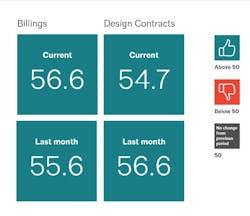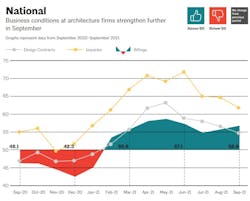AIA Billings Index Logs Eighth Straight Month of Growth
PRESS RELEASE
WASHINGTON – Oct. 20, 2021 – Architecture firms continue to report increasing demand for design services in September, according to a new report from The American Institute of Architects (AIA).
The Architecture Billings Index (ABI) score for September was 56.6, which is up from August’s score of 55.6. Any score above 50 indicates an increase in billings from the prior month. During September, scoring for both the new project inquiries and design contracts moderated slightly, but remained in positive territory, posting scores of 61.8 and 54.7 respectively.
“The ABI scores over the last eight months continue to be among the highest ever seen in the immediate post-recession periods that have been captured throughout the index’s history,” said AIA Chief Economist, Kermit Baker, Hon. AIA, PhD. “However, it’s unlikely that revenue increases at architecture firms can sustain this pace. Given that growth in both new design contracts and project inquiries have moderated in recent months, we expect to see a similar path for the ABI.”
Firms continue to report plenty of work in the pipeline as well, with inquiries into new projects and the value of new design contracts remaining strong. In addition, backlogs at architecture firms reached a new high since AIA started collecting the data on a quarterly basis in late 2010, now averaging 6.6 months.
Firm billings remained strongest at firms located in the Midwest in September, and business conditions also strengthened further at firms located in the South. Billings growth continued to soften at firms located in the Northeast, but remained positive overall. Firms with a commercial/industrial specialization reported the strongest billings for the eighth consecutive month, although business conditions remain robust at firms with multifamily residential and institutional specializations as well.
Employment rebounds, but inflation causes concern
In the broader economy, employment growth slowed in September, with nonfarm payrolls adding just 194,000 new jobs, far below the average monthly gains of 561,000 for the year so far. However, architectural services employment continued to rebound in August (the most recent data available), adding a substantial 1,700 new positions. Architectural services employment is now just 1% below its pre-pandemic peak, while overall national employment is still 3% below its peak.
However, there remain concerns about inflation, which has continued to rise in recent months. The latest Consumer Price Index (CPI) data shows that inflation rose by 0.4% in September, and is now up by 5.4% from September 2020. This month’s increase was led by rising costs for many consumer basics, such as energy, food at and away from home, and housing. And energy prices in particular are expected to continue increasing over the coming months, as is inflation in general, as supply chain and inventory issues linger.
Firms see technology as an investment worth making
This month’s special practice questions asked firms about the use of technology at their firms in recent years, and the benefits they have seen from these technology investments. Overall, nearly all responding firm leaders (97%) characterized their staff and firm as being at least somewhat technologically sophisticated compared to their peers, with one quarter considering themselves to be very technologically sophisticated.
For implementation of different types of technology as part of their practice, highest adoption was reported for communication and collaboration technology solutions (68% have made notable to full investment in this technology) and project management and delivery technology solutions (63% have made notable to full investment). Nearly half of firms (47%) reported at least moderately high adoption of firm management technology solutions, with an additional 31% reporting a medium level of adoption, defined as adoption of technology sufficient for their work. One third of firms reported at least moderately high adoption of social media for their firm.
However, few firms reported the adoption of energy/carbon/building performance technology solutions (three quarters reported moderately or very low adoption), or emerging technologies like augmented reality, artificial intelligence, wearable technology, Blockchain, robotic process automation, or parametric design (80% reported moderately to very low adoption). Large firms are much more likely to report a higher degree of investment in all types of technology than small firms, although nearly an equal share of small firms have made a strong investment in energy/carbon/building performance technology solutions as large firms (10% of small firms versus 11% of large firms).
At those firms that have adopted different types of technology at a moderately or very high level, they reported that they have seen a variety of benefits from that technology. Nearly all firms that have made notable to full investment in project and firm management technology indicated that it has allowed for better communications/smoother interaction within the project team, while a significant share also indicated that these technologies have allowed their firm to operate more productively/profitably, and save time and money through increased efficiency.
Although few firms have invested significantly in energy/carbon/building performance technology solutions, those that have indicated that this technology has helped their firm achieve better environmental performance, create better design, and keep up with/stay ahead of the competition. And firms that have made significant investments in emerging technologies indicated that they have primarily helped their firm create better design, keep up with/stay ahead of the competition, allowed for better communications/smoother interaction within the project team, facilitated their ability to market services, and allowed their firm to operate more productively/profitably.
This month, Work-on-the-Boards participants are saying:
- “Work remains very strong, especially in our K–12 market. There is very little capacity for new work with MEP engineering.”—100-person firm in the Midwest, institutional specialization
- “The majority of the owner/developer clients on the west coast are trying to ascertain timing of when to start their projects based on material escalation and supply chain issues the industry is facing.”—125-person firm in the West, commercial/industrial specialization
- “Lots of marketing activity. Starting to see work in the office increase.”—51-person firm in the Northeast, mixed specialization
- “Conditions are steady. Some clients appear to be standing on the sidelines waiting to see what happens to the economy.”— 4-person firm in the South, commercial/industrial specialization.
##########

